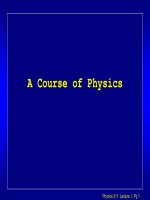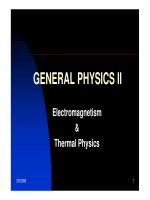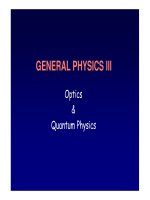- Trang chủ >>
- Khoa Học Tự Nhiên >>
- Vật lý
Tài liệu Chapter XXIII Nuclear Physics pdf
Bạn đang xem bản rút gọn của tài liệu. Xem và tải ngay bản đầy đủ của tài liệu tại đây (372.55 KB, 22 trang )
GENERAL PHYSICS III
Optics
&
Quantum Physics
Chapter XXIII
Nuclear Physics
§1. The structure and properties of nuclei
§2. Nuclear binding energy and nuclear force
§3. Nuclear stability and radioactivity
It is well known for you that every atom contains as its center
a nucleus that is:
positively charged
much smaller in size than the atom
carrying almost the total mass of the atom
This chapter provides deeper knowledge about NUCLEI
§1. The structure and properties of nuclei:
1.1 The structure of nuclei:
• Nucleus consist of two sorts of particles: protons (p) and neutrons (n).
• The mass of nuleons:
(the common name: nucleons)
mp = 1.007276xu; mn = 1.008665xu; (Note: me = 0.000548580 x u).
where 1u = 1.66053873x10-27 kg → the atomic mass units.
In nuclear physics, the masses of particles are usually expressed
in the energy units – MeV . (It is based on the formula E = mc 2 ). Then,
1u = 931 MeV mp = 938.2 MeV; mn = 939.5 MeV; (me = 0.511 MeV)
1.2 The spin and magnetic moment:
• Protons and neutrons have the same spin s = ẵ
ã The magnetic moment: = +2.49 ; = -1.91
p
N
n
N
e
. 05079 J / T
5
10 27
: the nuclear magneton
N
N
2m p
(It is 1386 times smaller than the Bohr magneton)
• An application of the proton spin: Magnetic Resonance Imaging
In order to image tissue of various types, Magnetic Resonance
Imaging detects the small difference in the numbers of “up” and
“down” hydrogen proton spins generated when the object studied is
placed in a magnetic field.
Magnetic resonance imaging (MRI) depends
on the absorption of electromagnetic radiation
by the nuclear spin of the hydrogen atoms
in our bodies (in water molecules).
The nucleus is a proton with
spin ½, so in a magnetic field B there are only
two possible spin directions with definite energy.
The energy difference between these states is
B, with = 1.41 x 10-26 J /Tesla.
E=2 p
p
B
0
B=0
pB
E
B
Example: A typical magnitude of magnetic field is 1 Tesla.
Then
pB = 2 x (1.41 x 10-26 J/T) x 1 T = 2.82 x 10-26 J
E
= 2.82 x 10-26 J x 1 eV/ 1.6 x 10-19 J = 1.76 x 10-7 eV
the frequency f of photons that can be absorbed by this energy
f = / h
E
difference:
= 2.82 x 10-26 J / 6.626 x 10-34 J.sec = 42 MHz
Radio waves
These radio-band signals depends on the microscopic properties of the
object and give the image of the object.
1.3 Mass and radius of nuclei:
• We have for a nucleus:
The mass number =
the total number of
protons and neutrons
The number
of neutrons
A = Z + N
The atomic number =
the ordinal numeral of the
element in the Periodic Table
= the charge number
= the number of protons
Denote a nucleus by the symbol:
XA
Z
( 1H1 ,
4
16
2He , 8O ,…
)
• The isotopes of an element: the nuclei that have the same Z (that is
belong to the same element), but different A
Examples:
The isotopes of hydrogen: 1H 1 , 1 H2 (deuterium), 1H3 (tritium)
The isotopes of carbon: 6C12 (carbon-12), 6C13 (carbon-13); etc.
It is known today about 2500 different nuclei (including different
isotopes). 300 nuclei are stable, the rest nuclei are unstable (radioactive).
• The radius of nuclei: The rather exact results of measuments give
r 1 . 3 15 A 1 / 3 m 1 . 3 A 1 / 3 fermi
10
(1fermi 10 15 m)
§2. Nuclear binding energy and nuclear force:
2.1 Nuclear binding energy:
The component paricles (protons, neutrons) of a nucleus bind strongly
together inside it. The evidence for this is that we must spend an amount
of energy (to bombard the nucleus by other particles) to separate a
nucleus to individual protons and neutrons.
Thus we have for the nuclear binding energy EB the following equation:
EB = { [Z.mp + (A-Z).mn] – M }.c2
The total mass of separate nucleons
>
The mass of nucleus
The difference [the total mass of separate nucleons - the mass of nucleus] is called
the mass defect of the nucleus.
• Note: The last equation can be written in terms of atomic masses:
EB = { [Z.mH + (A-Z).mn] – Matom }.c2
This equation is more convenient, because there are usually in Tables
not nuclear masses, but the atomic masses.
• Example: For 2He4:
M atom = 4.0026 u = 3728.0 MeV
EB = [ 2 x 938.7 + 2 x 939.5 ] – 3728.0 = 28.4 MeV
the binding energy EB
The binding energy per nucleon: It is the ratio
the number of nucleons A
An important observation is that
the binding energy per nucleon is nearly the same for almost nuclei !
The dependence of EB /A on A for all nuclei is as follows
The graph represents the dependence of the binding energy per nucleon
(EB/A) as a function of mass number A.
Remarks:
• The maximum of EB/A is for the values A ~ 50 ÷ 60 (Cr ữ Zn).
It is about 8.7 8.8 MeV.
ã Light nuclei (with few nucleons) have small EB/A (for example,
EB/A ~ 1.1 MeV for 1H 2 (deuterium); EB/A ~ 7.1 MeV for 2He4).
• EB/A for heavy nuclei decreases as increasing A
( EB/A ~ 7.5 MeV for the isotopes of uranium).
This dependence of EB /A on A leads to important consequences.
Two possibilities of giving off energy:
Nuclear Fission: Division of a heavy nucleus into two fragments of
comparable mass
Nuclear Fusion: Synthesis of some light nuclei to form a larger nucleus
Example:
• Division of a nucleus with A = 240 into two pieces of A = 120 (fission):
(EB) f = 2x8.5x120 MeV
(EB) i = 7.5x240 MeV
= 2.040 MeV
= 1.800 MeV
So after division the binding energy of the system increases about
240 MeV. Since binding energy is negative → the total energy of the
system decreases → the remainder (240 MeV) converts into the kinetic
energy of the fragments. The division of isotopes of Uranium, Plutonium,…
gives large sources of energy – called the atomic energy.
• Synthesis of two nuclei 1 H2 into the nucleus 2He4 (fusion):
(EB) f = 7.1x4 MeV
(EB) i = 2x1.1x2 MeV
= 28.4 MeV
= 4.4 MeV
The remainder about 24 MeV is given off.
This type of energy is called the fusion energy.
• Comparision: With the same mass of material the synthesis reaction
give off much more energy than the division reaction.
2.2 Nuclear force:
The large binding energy of nucleons inside nucleus is the evidence of
the strong interaction between nucleons there exists forces between
them, and this kind of forces is called nuclear forces.
Some charisteristics of nuclear forces:
They must be attractive, and much stronger the repulsive electrical
forces between positive-charged protons.
They are short-range forces: The range is of the order 10-15 m.
They become negligible at distances d > 2.10-15 m.
At d < 10 -15 m the attractive forces are replaced by the repulsive.
They do not depend on the eletrical charge of nucleons. The binding
forces have the same magnitude for two protons, or two neutrons,
or proton and neutron. This is an important feature and called
the charge-independence of nuclear forces.
They depend on the mutual orientation of nucleons. The binding
forces favour paires of protons or neutrons with opposite spins.
They have the property of saturation: It means that one nucleon
cannot interact simultaneously with all other nucleons in the nucleus,
but only with those few in its vicinity (otherwise the binding energy
per nucleon will not be nearly constant).
To give a theoretical basis for these characteristics of nuclear forces
one introduced models of nuclei. There is no completely perfect model,
every model has successfulness and disvantage.
§3. Nuclear stability and radioactivity:
Among 2500 known nuclei, there are about 300 stable. The others are
unstable, and they decay to convert into other nuclei with emitting
particles and electromagnetic radiation. This kind of processes is called
radioactivity.
We consider the following processes:
(i)
-decay;
(ii)
-decay;
3.1 Alpha decay:
In this process a nucleus emits the nuclei 2He4 (
-particles):
Example:
XA →
Z
U238 →
92
YA-4 + 2He4
Z-2
Th234 +
90
He4
2
• Alpha decay is usually accompained by
-rays (electromagnetic radiation)
• The velocity of emmited a-particles is about
10 7 m/s, the kinetic energy ~ few MeV.
• When
-particles travel through matter, they
ionize molecules of matter, loss their energy
and stop. The race in normal air: several
centimeters, in solid: several tens of
micrometers (
-particles cannot pass
through an usual paper sheet).
• Alpha decay is the tunnel effect of
-particles
through a potential-energy barrier as shown in the picture.
3.2 Beta decays:
+
There are 3 types of
-decays: , , and electron capture.
3.2.1 decay:
~
X A Z Y A 1 e0
Z
1
~
• A typical process:
n p
e
anti-neutrino
A free neutron is
-radioactive particle.
• Another example:
~
Th 234 Z Pa 234 1e0
90
1
(thorium)
(protactinium)
• The energy of emitted electrons
in this decay is not definte, but
has a continuous spectrum from 0
to Emax.
• The speeds of electrons are up to
0.9995 c the electron’s motion
is relativistic.
• Anti-neutrino:
It is the anti-particle of neutrino. Both neutrino and its anti-particle
have the rest mass 0
It is neutral the electric charge of the system is conserved
Its spin is ½ the total spin of the system is conserved
It shares the given off energy in the
decay process with the
electron. The given off energy is distributed between the electron
and the anti-neutrino in different ways, holding the energy
conservation.
+
3.2.2 decay:
• The scheme:
• Example:
X Z Y 1 e
1
A
Z
0
N 6 C 1e
13
7
A
13
0
neutrino
pozitron
• Note: Since the mass of proton is smaller than that of neutron,
p n is impossible for free protons.
e
the process
(But it is possible for protons inside nuclei by taking energy from
other nucleons).
3.2.3 Electron capture (K-capture):
• It is the process in which the nucleus absorbs one of the electrons in
K-shell of the atom (or in L-, M-shells, but with small probabilities). In
the result, one of protons converts to neutron:
p n
e
and the corresponding transformation of the nucleus is
X A 1e 0 Z Y A
Z
1
• The place of the captured electron will be filled by an electron from
other shells this process is accompaned by emitting electromagnetic
waves in the band of X-rays.
• Example:
K 40 1e0 18 Ar 40
19
3.3 Decay rate and half-lives:
Suppose that we have an amount of radioactive matter. Due to
radioactive processes (decays), the initial nuclei transform into other
nuclei the number of the initial matter decreases in time.
• Denote by N(t) the number of nuclei (and also atoms) at the moment t.
During an interval dt the number of nuclei (atoms) decreases dN :
dN Ndt
ln N
t const
N ( t ) N 0 e t
where N0 = N(t=0) is the number of nuclei of the initial matter at t=0;
is a constant which characterizes the radioactivity of the matter. It
is different for different elements. called the decay constant.
is
• The half-life T 1/2 : By definition, it is the time required for the number
of radioactive nuclei to decrease to one-half the original number N0 .
• We can derive the relation between the half-life and the decay constant:
N0
N 0 e T1 / 2
2
T1 / 2
ln 2
0 . 693
• Unites for T1/2 → s, for 1/s.
→
• The half-lives are very different for different elements. For the known
elements the range of half-lives is from 3x10 -7seconds to 5x1015 years.
Summary
Any nucleus consists of the component particles: protons (p) and
neutrons (n)
Proton has the electrical charge +1, neutron has no charge
Spin of proton and neutron is ½
The nucleus
ZX
A
consists of Z protons and (A-Z) neutrons
The binding energy of the nucleons inside a nucleus is determined by
the mass defect of the nucleus (the difference between the total mass
of separate nucleons and the mass of nucleus).
The dependence of the binding energy per nucleon on the mass number A
gives predictions about characteristics of nuclear forces between
nucleons inside nucleus. It allows also to explain two ways of having
energy: fission and fusion.
Radioactivity: The most of nuclei are unstable under decay processes.
After decay processes the nucleus transforms into other nucleus.
The rate of radioactive process is described by the equation:
N ( t ) N 0 e
t
The half-life of an radioactive element T1/2: It is the required time
to decrease to one-half the initial amount of radioactive matter.









